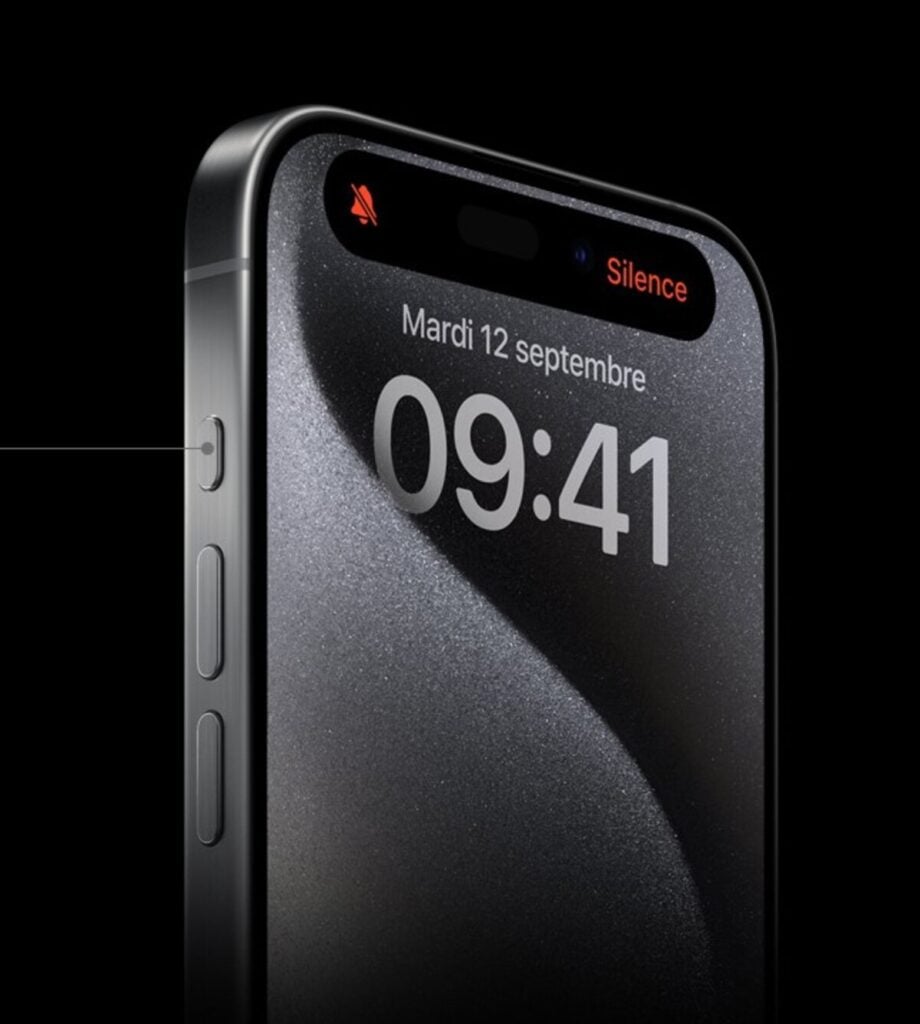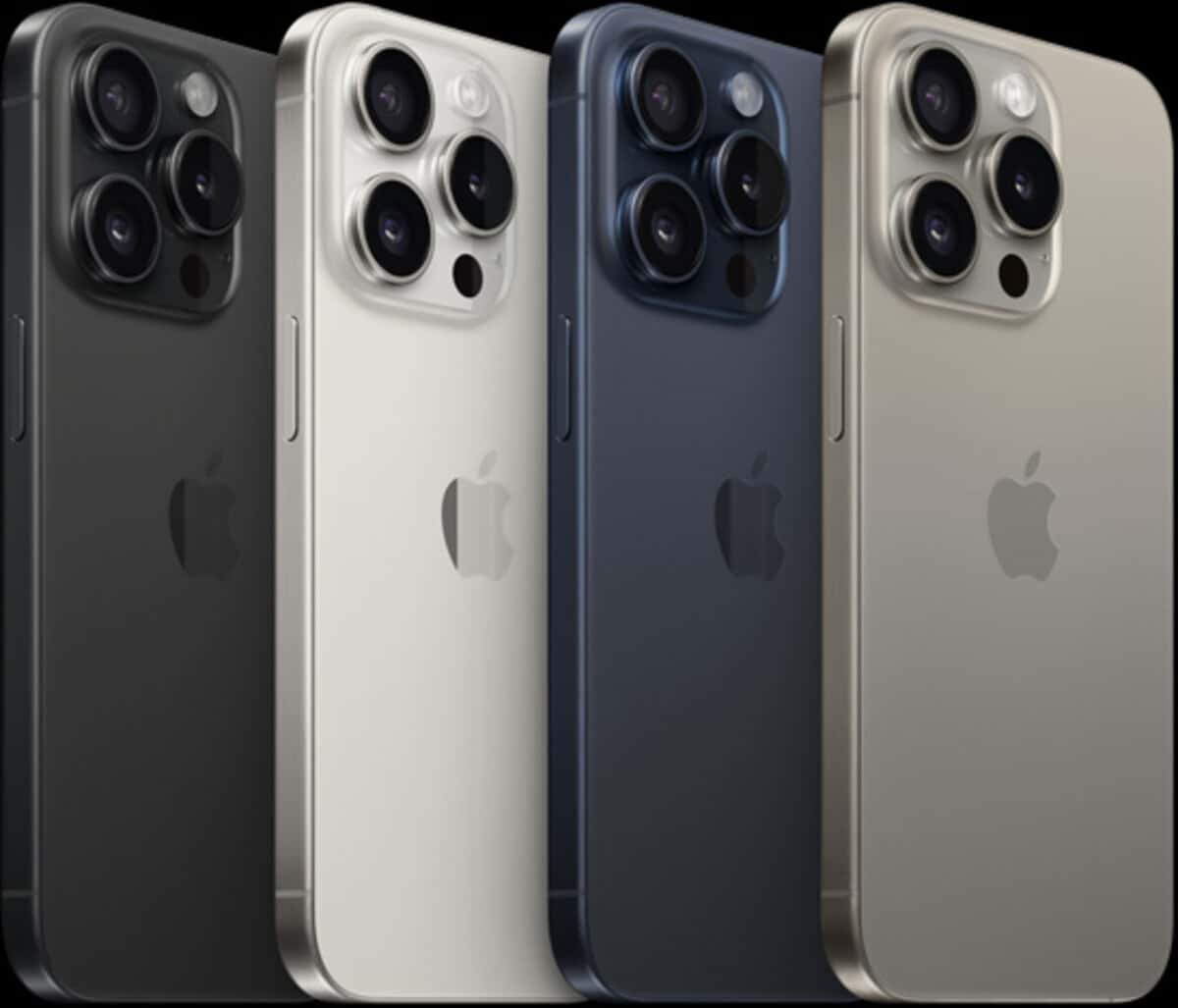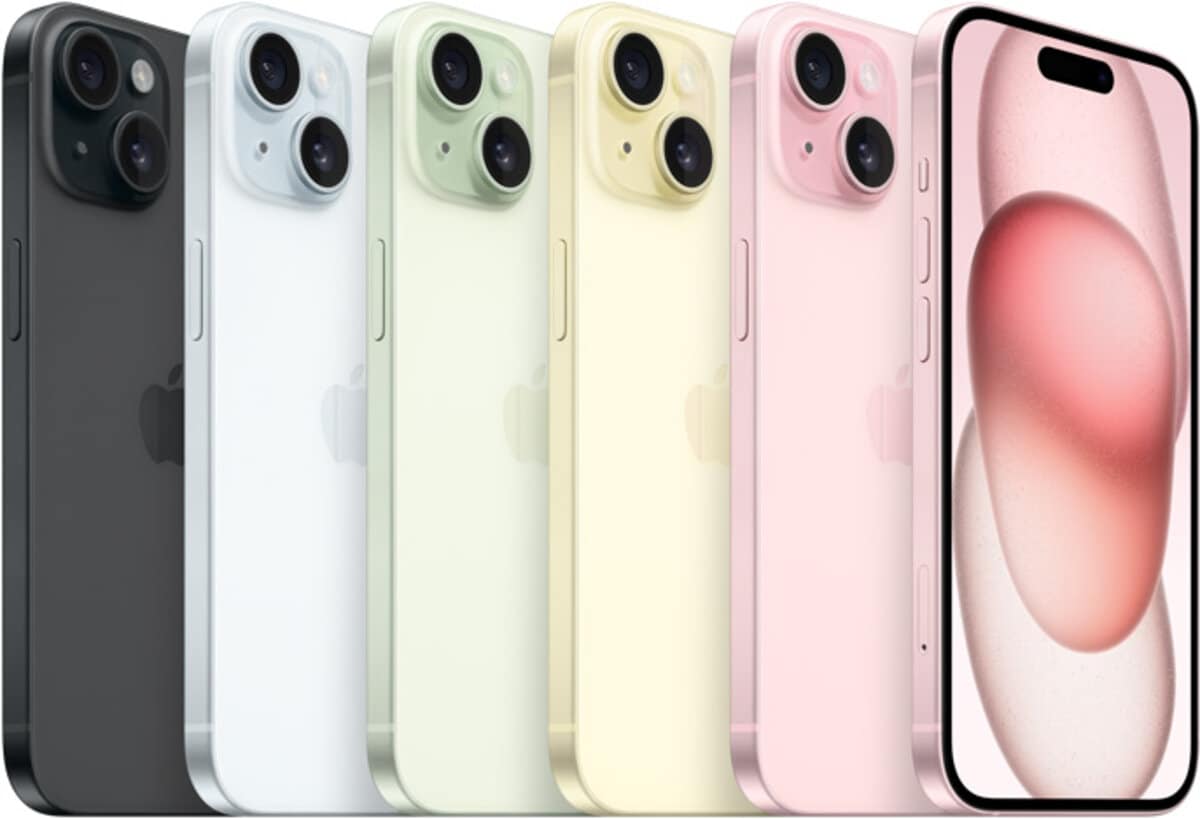Apple iPhone 15: features, specs, price, everything you need to know

As expected, Apple unveiled its iPhone 15s on September 12. These successors to the iPhone 14 introduce several major changes. Here’s an overview of these changes and the features of Apple’s new smartphones.
CONTENTS
On Tuesday September 12, Apple unveiled its new range of smartphones from California , the iPhone 15, alongside the Watch Series 9 connected watches. This generation follows in the footsteps of the iPhone 14. As usual, it’s the Pro models that are introducing the main new features, even though the Standard and Plus ranges have not been neglected by the manufacturer. Above all, for once Apple has lowered its prices.

First expected change: to comply with European standards, all iPhone 15s adopt the USB-C port. Most of the major innovations are to be found on theiPhone 15 Pro andiPhone 15 Pro Max. The latter benefit from a new, fully removable titanium shell, and above all from the new A17 chip, the first to be etched in 3nm by TSMC; there’s no trace of 35-watt fast charging, however… Non-Pro models are nonetheless entitled to several improvements, including a new 48 MP sensor for the entire range.

The smartphones have been available for pre-order since September 15. The first deliveries will begin on September 22.
Read all the latest news about Apple’s iPhone 15 :
- iPhone 15 Pro Max: exactly how much titanium are we talking about?
- iPhone 15 Pro underperforms with iOS 17.0.3 anti-overheating update?
- iPhone 15: Apple’s flagship weakness finally identified?
What design for iPhone 15?
The design of the iPhone 15 remains fairly similar to that of the iPhone 14 models. There are a few notable differences, however:
- Pro range models feature a fully removable titanium shell;
- Apple has added new colors;
- Screen contours are more refined;
- The Dynamic Island is available on all models;
- The addition of the USB-C port;
- The Pro range features a new action button.

The iPhone Pro 15 range features a new titanium shell, making these models lighter and stronger than the iPhone 14 Pro. The added value is clear: 40% lighter than stainless steel, with 3-4 times the strength.
In addition to increased strength, this material makes for lighter smartphones. The iPhone 15 Pro weighs 187 grams, compared with 206 grams for its predecessor; the iPhone 15 Pro Max weighs 221 grams, compared with 240 grams for the 14 Pro Max.
The titanium element also introduces new color shades, to mark the change. Users can choose between black titanium, white titanium, blue titanium and natural titanium.

The Standard and Plus ranges retain a stainless steel shell and are available in black, blue, green, yellow and pink.

All the dimensions and weights of the four iPhone 15 variants are given in the table below.
| Smartphone | Height (mm) | Width (mm) | Thickness (mm) | Weight (grams) |
| iPhone 15 | 147,6 | 71,6 | 7,8 | 171 |
| IPhone 15 Plus | 160,9 | 77,8 | 7,8 | 201 |
| IPhone 15 Pro | 146,6 | 70,6 | 8,25 | 187 |
| IPhone 15 Pro Max | 159,9 | 76,7 | 8,25 | 221 |
What’s more, this is a change that has been awaited for many years on Apple smartphones: simplified accessibility of the phone’s interior. Apple responded last year for its most affordable range with the iPhone 14, but this improvement had not yet been implemented for the top of the range. The information still requires confirmation, but the iPhone 15 Pro and Pro Max would see their titanium shells fully removable, as is already the case today on the iPhone 14, but not on the iPhone 14 Pro and Pro Max. If so, this would be Apple’s first high-end generation to benefit from it, and it will greatly reduce maintenance and repair costs for these smartphones.
On the other hand, the screen protectors on the new iPhone 15 are thinner and slightly curved, similar to those on the iPhone 11.
iPhone 15: components and features
We remember the iPhone Pro 14 and its new A16 Bionic chip, the new Always-On display, the new sensor for the main camera, but what about the iPhone 15?
The iPhone 15 Pro is equipped with the new A17 Bionic chip, said to be as powerful as the MacBook’s M1 processor. This chip mobilizes 6 CPU cores (2 performance cores and 4 energy-efficient cores) and 6 GPU cores, so the era of 8 CPU cores isn’t just around the corner for Apple. A 16-core Neural Engine completes the picture.
The real revolution this year comes from 3nm etching, which, on paper, saves up to 35% energy. For chip production, Apple has negotiated an exceptional agreement with TSMC that will save several billion dollars.
The brand is also focusing on GPU capabilities. On the program: hardware support for ray tracing (already offered by current generations of Android SoCs: Snapdragon 8 Gen 2, Dimensity 9200 and Exynos 2200) and the promise of a chip perfectly suited to gaming.

For the standard range, the iPhone 15 and 15 Plus make do with the A16 Bionic chip now found in the iPhone Pro 14.

On the software side, Apple smartphones run on iOS 17. Tested for several months, this version brings a host of new features, such as the ability to identify your cat (or dog, but not your dwarf rabbit).
RAM and internal storage
As for RAM, non-Pro iPhone 15s retain 6GB of LPDDR5 DRAM, as do iPhone 14s. The good news is that Pro models now come with 8GB of RAM.
For storage, customers can choose between 128GB, 256GB or 512GB capacity for all iPhone 15s, with the exception of the Max Pro, which comes with a minimum of 256GB. Pro versions offer an additional 1TB option. The rumor that Apple would be going up to 2TB this year was therefore false.
A new action button on Pro models
Since iPhone 14, all models sold in the U.S. have no SIM card compartment, but feature eSIM, which is a pseudo-SIM card directly integrated into the smartphone’s motherboard, and completely non-removable. This technology improves the waterproofing of iPhones, as well as the physical space where the SIM compartment was installed. For iPhone 15, Apple is offering dual SIM (nano-SIM and eSIM) across the entire range.
Note that all models are now entitled to Dynamic Island, a technology present on iPhone Pro 14. This allows you to view alerts and actions in progress on the smartphone, in the space reserved for the front cameras.
Finally, as reported at the start of this article, the iPhone 15 Pro range also features a new action button, replacing the mute button found on previous iPhones. This Action button is a shortcut to the user’s preferred functionality, which he or she is free to choose (camera, flashlight, etc.).

iPhone 15: what capacity batteries?
Increased capacity is expected for all iPhone 15 models, with an increase of between 12 and 18% depending on the model. Unfortunately, Apple has not revealed any details. According to previous rumors, the capacities would be as follows:
- iPhone 15: 3,877mAh (14: 3,279mAh)
- iPhone 15 Plus: 4,912mAh (14: 4,325mAh)
- iPhone 15 Pro: 3,650mAh (14: 3,200mAh)
- iPhone 15 Pro Max: 4,852mAh (14: 4,323mAh)
These increases would confirm Apple’s desire to increase the autonomy of all its devices, in parallel with the new A17 chip and the A16 on the standard range. We’ll have to wait for the first devices to be delivered to find out whether or not these speculations are true. The only certainty for the moment is the claim of 29 hours of video playback autonomy for the iPhone 15 Pro, compared with 26 hours for the iPhone 15 and iPhone 14. So it’s likely that the A17 is the main factor behind this increase.
It should also be noted that the iPhone 15 range will benefit from new options to optimize battery recharging. In particular, this will enable recharging to be blocked at a maximum of 80%. This will reduce autonomy but increase battery life.
What connectors and connectivity for iPhone 15?
The new generation iPhone no longer features a Lightning connector. This decision follows the European directive that makes USB-C ports mandatory on all smartphones on the market from December 28, 2024, and from 2026 for computers. Apple has chosen to get ahead of the game and comply now, for all its future product ranges.
However, only the Pro range is equipped withUSB-C supporting version 3.2 and Thunderbolt 3 (up to 10 Gbit/s), while models in the standard range are limited to USB 2.0 (up to 480 Mbit/s). This means a big difference in data transfer speed.

Just like their latest brethren, the MacBook Pro, Mac mini and iPad Pro, iPhone 15 Pro models support Wi-Fi 6E (802.11ax) technology, enabling even faster wireless connections to compatible access points. Non-Pro models remain on Wi-Fi 6 (802.11ax). All, however, benefit from Bluetooth 5.3.
iPhone 15: what’s new and improved on the optical side
Apple wants to shake up the world of photography on our smartphones this year, with several important changes.
The main sensor on all iPhone 15 models is a 48 MP model (26 mm, ƒ/1.6 aperture for iPhone 15 and 15 Plus; 24 mm, ƒ/1.78 aperture for iPhone 15 Pro models). This sensor, created by Sony, is said to deliver far superior photo quality, especially in complicated conditions, such as with varying brightness during cloudy weather. Tests will tell.
This main sensor is complemented by a 12 MP ultra-wide-angle lens (13 mm, aperture ƒ/2.4 for non-Pro models; 13 mm, aperture ƒ/2.2 for Pro models), a 2x 12 MP telephoto lens (52 mm, aperture ƒ/1.6 for non-Pro models; 48 mm, aperture ƒ/1.78 for iPhone 15 Pro). The iPhone 15 Pro also features a 3x 12 MP telephoto lens (77 mm, aperture ƒ/2.8) and the Max version a 5x 12 MP telephoto lens (120 mm, aperture ƒ/2.8).
All these iPhones can handle 4K video at up to 60 frames per second.

Finally, there’s no special treatment for the selfie camera, with a 12 MP sensor (ƒ/1.9 aperture) for all four versions.
Which screens for iPhone 15?
The entire range uses OLED Super Retina XDR panels. The iPhone 15 and 15 Pro have a diagonal of 6.1 inches, while the iPhone 15 Plus and 15 Pro Max have a diagonal of 6.7 inches. In all cases, Apple reports standard brightness of 1,000 cd/m2, peak brightness of 1,600 cd/m2 (HDR) and peak brightness of 2,000 cd/m2; standard contrast ratio of 2,000,000:1.
The 6.1-inch models have a maximum definition of 2,556 x 1,179 pixels, while the 6.7-inch screens have a maximum definition of 2,796 x 1,290 pixels. The resolution is therefore the same: 460 dpi.
How much does the iPhone 15 cost?
In the end, this was one of the main surprises of the presentation: the rating is not increasing for the iPhone 15. Better still, it’s down on last year’s score. Buy iPhone 15 on AmazonBuy iPhone 15 Plus on AmazonBuy iPhone 15 Pro on AmazonBuy iPhone Pro Max 15 on Amazon
The iPhone 15 is available from 969 euros, while its ancestor retailed for at least 1019 euros. On the other side of the range, the iPhone 15 Pro Max is available from 1,479 euros. That’s the same price as the iPhone 14 Pro Max when it first came out… but in a 128GB version.
| Model | iPhone 15 Pro Max | iPhone 15 Pro | iPhone 15 Plus | IPhone 15 | iPhone 14 Pro Max | iPhone 14 Pro | iPhone 14 Plus | iPhone 14 |
| 128 GB | – | 1129 euros | 1119 euros | 969 euros | 1,479 euros | 1,329 euros | 1169 euros | 1019 euros |
| 256 GB | 1,479 euros | 1,359 euros | 1,249 euros | 1099 euros | 1,609 euros | 1,459 euros | 1,299 euros | 1149 euros |
| 512 GB | 1729 euros | 1,609 euros | 1499 euros | 1,349 euros | 1869 euros | 1,719 euros | 1,559 euros | 1,409 euros |
| 1 TB | 1979 euros | 1859 euros | – | – | 2129 euros | 979 euros | – | – |
Source : Apple











